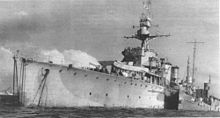Danae-class cruiser

| |
| Class overview | |
|---|---|
| Name | Danae class |
| Operators | |
| Preceded by | C class |
| Succeeded by | Emerald class |
| In commission | 1918–1946 |
| Planned | 12 |
| Completed | 8 |
| Cancelled | 4 |
| Lost | 3 |
| General characteristics | |
| Type | Light cruiser |
| Displacement |
|
| Length | |
| Beam | 46.5 ft (14.2 m) (47 ft (14 m) in Despatch and Diomede) |
| Draught | 14.5 ft (4.4 m) (16.5 ft (5.0 m) full) |
| Propulsion |
|
| Speed | 29 knots (54 km/h; 33 mph) (27 knots full) |
| Range | 2,300 nmi (4,260 km) at 27 knots (50.0 km/h) |
| Complement | 450 / 469 war |
| Armament |
|
| Armour |
|
The Danae or D class consisted of eight light cruisers built for the Royal Navy at the end of World War I which also saw service in World War II.
Design

The Danaes were based on the design of the preceding
Modifications

The lessons of the Battle of Jutland were applied and protection was improved in detail. Additional torpedo tubes were installed and depth charge throwers were also included. The Mk XII 6-inch (152 mm) gun was retained but, in Diomede, a new prototype gun house (allowing greater elevation) was used and found to be most satisfactory.
Inter-war, all ships had their anti-aircraft armament standardised as three
Early modifications in World War II included the addition of Radar Type 286 air warning at the foremast head and, later, Type 273 centimetric target indication set on the searchlight platform amidships. Between 6 and 8 20 mm Oerlikon guns were generally added, replacing the old 2 pounder guns in the bridge wings, on either side of 'P' and 'Q' guns and on the quarterdeck. In 1942, Dauntless (and in 1943, Danae) had the aft 4 inch A/A gun replaced by a quadruple mounting Mark VII for the 2 pounder Mark VIII gun and in 1943, Danae and Dragon had 'P' gun and the forward pair of 4-inch (102 mm) guns replaced by two such mountings and their Radar Type 282 equipped directors. Dragon and Danae were taken in hand again in 1943 and had the aft 4 inch / 2 pounder mountings replaced by a twin Mounting Mark XIX for the

Between 1941 and 1942, Delhi was rebuilt in the
Dragon and Durban were expended as breakwaters in support of the Normandy landings in June 1944, Dragon being replaced in Polish service by the Danae (as ORP Conrad) and Despatch was disarmed as a depot ship.
Ships
Three ships were ordered in Sep 1916 under the War Emergency Programme:
| Ship name | Pennant no. | Builder | Ordered | Laid down | Launched | Completed | Fate |
|---|---|---|---|---|---|---|---|
| Danae | D44 | Sir W. G. Armstrong Whitworth and Company, High Walker | Sep 1916 | 11 Dec 1916 | 26 Jan 1918 | 18 Jul 1918 | Transferred to the Polish Navy as ORP Conrad, 4 Oct 1944 – 28 Sep 1946; sold for breaking up, 22 Jan 1948 |
| Dauntless | D45 | Palmers Shipbuilding and Iron Company, Jarrow | 3 Jan 1917 | 10 Apr 1918 | 2 Dec 1918 | Sold for breaking up, 13 Feb 1946 | |
| Dragon | D46 | Scotts Shipbuilding and Engineering Company, Greenock | 24 Jan 1917 | 29 Dec 1917 | 16 Aug 1918 | Transferred to Polish Navy, 15 Jan 1943; damaged by manned torpedo off Caen, 8 Jul 1944; written off and expended as breakwater off Normandy beaches , 20 Jul 1944
| |
| Delhi | D47 | Armstrong Whitworth | Jul 1917 | 29 Oct 1917 | 23 Aug 1918 | 7 Jun 1919 | Sold for breaking up, 22 Jan 1948 |
| Dunedin | D93 | Armstrong Whitworth | 5 Nov 1917 | 19 Nov 1918 | Oct 1919 by Devonport Royal Dockyard | Torpedoed and sunk by the Saint Paul's Rock in the South Atlantic, 24 Nov 1941
| |
| Durban | D99 | Scotts | 22 Jun 1918 | 29 May 1919 | 1 Sep 1921 by Devonport Royal Dockyard | Expended as breakwater off Normandy beaches, 9 Jun 1944 | |
| Despatch | D30 | Fairfield Shipbuilding and Engineering Company, Govan | Mar 1918 | 8 Jul 1918 | 24 Sep 1919 | 2 Jun 1922 by Chatham Royal Dockyard | Sold for breaking up, 5 Apr 1946 |
| Diomede | D92 | Vickers Limited, Barrow-in-Furness | 3 Jun 1918 | 29 Apr 1919 | 24 Feb 1922 by Portsmouth Royal Dockyard | Sold for breaking up, 5 Apr 1946 | |
| Daedalus | — | Armstrong Whitworth | — | — | — | Cancelled 26 Nov 1918 | |
| Daring | William Beardmore and Company, Dalmuir | ||||||
| Desperate | R. & W. Hawthorn Leslie and Company, Hebburn on Tyne | ||||||
| Dryad | Vickers |
Notes
References
This article includes a improve this article by introducing more precise citations. (April 2009) ) |
- Campbell, N.J.M. (1980). "Great Britain". In Chesneau, Roger (ed.). Conway's All the World's Fighting Ships 1922–1946. New York: Mayflower Books. pp. 2–85. ISBN 0-8317-0303-2.
- ISBN 978-1-86176-281-8.
- ISBN 978-1-59114-078-8.
- Friedman, Norman (2011). Naval Weapons of World War One: Guns, Torpedoes, Mines and ASW Weapons of All Nations; An Illustrated Directory. Barnsley, UK: Seaforth Publishing. ISBN 978-1-84832-100-7.
- ISBN 1-55750-048-7.
- ISBN 0-85177-245-5.
- Raven, Alan & Roberts, John (1980). British Cruisers of World War Two. Annapolis, Maryland: Naval Institute Press. ISBN 0-87021-922-7.
- ISBN 1-59114-119-2.
- ISBN 1-86019-874-0.
